32.6: Algae - an Introduction
- Page ID
- 101855
Search Fundamentals of Biochemistry
In the previous chapter sections, we discussed bioethanol production from plant starches (first generation) and lignocellulosic plants (second generation) from biomass waste such as stover and sugar cane. Each had its challenges. Now we will consider the third generation production of bioethanol from algae which has significant potential for minimizing damage to the environment. Below in Figure \(\PageIndex{1}\) is a summary of bioethanol production from each generation feedstock.
Figure \(\PageIndex{x}\): Figure 1. General flowchart of bioethanol production, comparing the pre-fermentation processing of feedstocks for the first three generations of bioethanol production. The blue highlighted area provides an example of a value-added process that can enhance the value of bioethanol production. Tse, T.J.; Wiens, D.J.; Reaney, M.J.T. Production of Bioethanol—A Review of Factors Affecting Ethanol Yield. Fermentation 2021, 7, 268. https://doi.org/10.3390/fermentation7040268. Creative Commons Attribution (CC BY) license (https://creativecommons.org/licenses/by/4.0/)
There are so many types of algae that it can be daunting to read about them. Some are single cells, some can form filaments and colonies, and some are multicellular with different cell types. Some are prokaryotes; some are eukaryotes.
The Algae Database suggests that they are best defined as "oxygenic photosynthesizers other than embryophyte land plants". Naming and classification are generally based on botanical names ending as follows: phyla = -phyta, classes = -phyceae, order = -ales, and family = -aceae. The main groups are blue-green algae (cyanobacteria), rhodophytes, phaeophytes, chlorophytes, euglenophytes, charophytes, diatoms, dinoflagellates, and cryptophytes. To make it more complicated, some animal species have been categorized as algae and have zoological name endings ( -zoa, -ea, -ida, -idae). We apologize in advance for any errors and inconsistencies in the description of algae in the chapter section and would ask that you contact us with corrections..
Before we discuss biofuel production from algae, we will review the different algae types (much as we did for zooplankton and phytoplankton). Broadly, algae can be divided into microalgae (seen with a microscope) and macroalgae (seen with the eye). There are almost 170,00 species of algae listed in the Algaebase.
Here is a summary of their properties. They can
- fix carbon and produce food by photosynthesis. As such, they are primary producers.
- be tiny (microalgae) or large and visible (macroalgae, also known as seaweed). Kelp, which can form large underwater forests, is a macroalgae.
- be unicellular, form colonies or filaments, or larger multicellular structures
- attach to objects or float freely.
Some who study algae (phycologists) often consider any organism with chlorophyll but without the stems, roots, leaves, flowers, and vessels of plants to be algae.
The naming and classification of algae are confusing, so let's start with a broad review of their classification.
Life can be divided into domains, kingdoms, phyla, and additional subcategories. Carl Woese proposed three domains, Archaea, Bacteria, and Eukarya, in 1990, based on analyses of ribosomal RNA sequences. These domains are further classified into kingdoms - Archaebacteria, (Eu)bacteria, Protista, Fungi, Plantae, and Animalia. A seventh kingdom was added in 1981 by Thomas Cavalier-Smith, who divided Protista was two kingdoms, Protista (unicellular eukaryotes like some protozoa and some molds) and a new kingdom, Chromista (uni- or multicellular eukaryotes such as algae, diatoms, and some protozoans). Both Protista and Chromista have organisms with chlorophyll, and both also have heterotropic organisms. Newer classifications based on additional biochemical data may yet be proposed. Table \(\PageIndex{1}\) below shows a summary of the domains and kingdoms of life.
| Domains and Kingdoms | |||||||
| Domain | Bacteria | Archaea | Eukarya | ||||
| Kingdom | (Eu)bacteria | Archaebacteria | Plantae | Animale | Fungi | Protista | Chromista |
Table \(\PageIndex{1}\): Domains and kingdoms of life.
All life arose from the last universal common ancestor, LUCA, as shown below in Figure \(\PageIndex{2}\).
Figure \(\PageIndex{2}\): Phylogenetic tree linking all major groups of living organisms to the LUCAhttps://upload.wikimedia.org/wikiped..._1990_LUCA.svg
Their biological classification of algae (which illustrates how widely spread they are among different domains, kingdoms, and phyla, shown below in Figure \(\PageIndex{3}\)
Figure \(\PageIndex{3}\): Distribution of algae among groups in the Tree of Life as recognized by the ITIS and Species 2000 (and ife.org) in 2011. The deep classification of algae is the subject of great debate, and even the higher clades have been discussed and revised recently. Adapted from Verdelho Vieira, V.; Cadoret, J.-P.; Acien, F.G.; Benemann, J. Clarification of Most Relevant Concepts Related to the Microalgae Production Sector. Processes 2022, 10, 175. https://doi.org/10.3390/pr10010175. Creative Commons Attribution (CC BY) license (https://creativecommons.org/licenses/by/4.0/).
Microalgae
Microalgae are single-cell organisms that can form filaments and colonies. This group has one prokaryotic member, cyanobacteria, also known as blue-green algae. As a prokaryote, it does not have mitochondria or chloroplasts. The rest of the microalgae are eukaryotic and include the phyla Chlorophyta, Rhodophyta, Glaucophyta, Cryptophyta, Euglenozoa, Cercozoa, Heterokontophyta, Haptophyta, and Miozoa (Myzozoa). Another simpler organizational system divides microalgae into four categories:
- cyanophyta (blue-green algae/cyanobacteria)
- pyrrophyta (dinoflagellates and cryptomonads, and can be yellowish-green to golden-brown)
- chrysophyta (diatoms, heterokonts and golden brown algae)
- chlorophyta (microscopic green algae). This term also applies to macroalgae (see below).
Green algae are really diverse and are now broken up into two phyla, chlorophyta and charophyta with a combined 17 classes. AlgaeBase dynamic species counts shows that there are about 4,500 species of Chlorophyta including those that live on land, in freshwater, and those that are considered macroalgae seaweeds. There are about 2500 species of Charophyta that are entirely freshwater.
Within the microalgae are found green, brown, and red algae. (Unfortunately for students of algae, there are also green, brown, and red macroscopic algae as well). Microalgae are much more efficient at photosynthesis than land plants. The diatoms are an example of microalgae and are the precursor of the "fossil" fuel oil deposits. Spirogyra is a unicellular green alga that forms long filaments (colonies) up to 0.1 mm in length, so it loosk like a multicellular organism.
One class of microalgae, green algae, arose when a microbe acquired a cyanobacterium, which allowed photosynthesis. Green algae eventually evolved into higher plants, and a similar process led to red algae. Brown algae and diatoms, dinoflagellates, and euglenoids, other types of algae, arose from the uptake of red or green algae into other eukaryotic host cells.
In general, green microalgae, which absorb red wavelengths, are found on the surface. The red microalgae, which absorb green, and blue wavelengths, are at lower levels. The brown microalgae are generally found in between these water layers. Figure \(\PageIndex{x}\) below shows the light penetration spectrum in water.
The energy of light photons is given by E=hν=hc/λ, where ν if the frequency of the light and λ is the wavelength. As highly energetic x-rays penetrate matter, visible light can penetrate water. Water absorbs incident radiation, with the lower energy, higher wavelength photons of red light absorbed more readily in the top layers while the blue light penetrates farther into the water. The depths of penetration of light in the open ocean (left) and coastal (right) waters are shown in Figure \(\PageIndex{4}\).
Figure \(\PageIndex{4}\): The light penetration spectrum in water as a function of color. https://oceanexplorer.noaa.gov/edu/m...fact-sheet.pdf
When you are underwater, everything seems blue since red light is preferentially absorbed, leaving photons enriched in blue light reaching our eyes. Blue-enriched light reaches our eyes as it reflects off of objects. Clear water in the open ocean also appears blue since there are fewer particles like phytoplankton from which light scatters back to our eyes. Rayleigh (or elastic light scattering) depends on 1/λ6, so low wavelength light scatters most from particles. Sunsets and sunrises appear red when light passes through more of the atmosphere and the blue light is scattered from atmospheric particles before reaching our eyes. Coastal waters have more sediment, algae, and microscopic organisms like plankton that can scatter light. These waters appear more green-blue, since red light is significantly absorbed by the microorganisms and blue light is more scattered.
Microalgae exist as single cells or can form multicellular filaments and colonies. They proliferate in the presence of simple nutrients and can produce large amounts of polysaccharides for industrial bioethanol production or fatty acids/triacylglycerols for biodiesel production. They are, as mentioned above, the source of underground oil deposits. Both freshwater (like Chlorella and Haematococcus) and ocean microalgae (Dunaliella, Phaeodactylum, and Tetraselmis) can be used for the production of biofuels. The cyanobacteria Spirulina sp. is commonly used for commercial purposes. It and Synechococcus have large amounts of glycogen that could be used for bioethanol production. Their triacylglycerols are low, so they can't be used for biodiesel (which we will discuss in a future section of the chapter).
Most are familiar with algae blooms in freshwater lakes (and even in saltwater environments). Cyanobacteria (blue-green algae) are the main culprit. Microcystin, a potentially lethal toxin that targets serine/threonine protein phosphatases, is released from some algae blooms. Figure \(\PageIndex{5}\) shows a microalgae bloom in Lake Erie, a shallow freshwater lake polluted with agricultural runoff, making it an excellent site for cyanobacterial blooms.

Figure \(\PageIndex{5}\): Microalgae bloom in Lake Erie, October 2011. https://commons.wikimedia.org/wiki/F..._Lake_Erie.jpg
Red tides are another type of toxic algae blooms that occurs in coastal water. Along US coast they are caused by dinoflagellates and one diatom, both phytoplankton and types of microalgae. Around the Gulf of Mexico, the main cause of red tides is the microalgae Karenia brevis. They release large amounts of brevotoxin, a polycyclic ether that binds to and activates voltage-gated Na+ channels in nerve and muscle. Hence it is a potentially deadly neuortoxin. The frequency of red tides is increasing around the world. Two images of red tides are shown in Figure \(\PageIndex{6}\).
 |
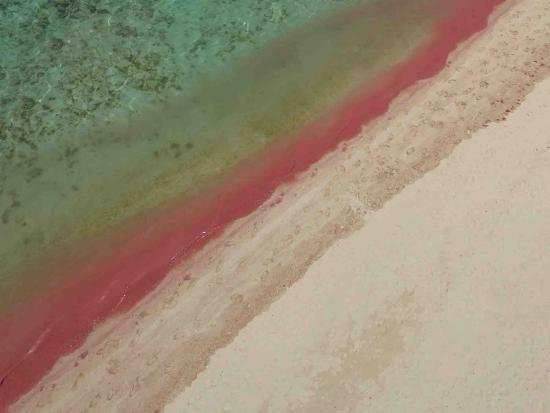 |
Figure \(\PageIndex{6}\): Red Tide. License from Shutterstock
Microalgae are sources of glycan polymers that can be used for bioethanol production; some are excellent candidates for biodiesel fuel, which is made from triacylglycerol reserves. Table \(\PageIndex{2}\) below shows a classification of microalgae and Cyanobacteria along with their characteristic pigments (that impart their distinctive colors) and their energy reserves that could be used for biofuel production.
| Phylum | Class | Pigments | Reserve | Habitat |
|---|---|---|---|---|
| Cyanobacteria | Cyanophyceae | Chl a, β-carotene, flavacene, Echinenone isozea-, zea-, myxo-, oscillaxanthin APC, C-PC, C-PE |
Starch (granule) and glycogen |
Marine Freshwater Terrestrial |
| Euglenophyta | Euglenophyceae | Some colorless Chl a, b, diadinoxanthin |
Paramylon Ergosterol |
Marine Freshwater Terrestrial |
| Heterokontophyta/ Ochrophyta |
Xanthophyceae Eustigmatophyceae |
Chl a and c, β-carotene, heteroxanthin, diadinoxanthin (++) | Oil Leucosin Ergosterol |
Marine Freshwater Terrestrial |
| Miozoa | Dinophyceae | Chl a, c, β-carotene, diadinoxanthin, dinoxanthin, peridinins | Starch Lipids |
Marine Freshwater |
| Heterokontophyta/ Ochrophyta |
Chrysophycea | Chl a, c, β-carotene, Fuco-, Diato-, diadinoxanthin |
Chrysolaminarin Fucosterol Porifasterol |
Marine Freshwater |
| Haptophyta | Coccolithophyceae Pavlovophyceae Rappephyceae |
Chl a, c, β-carotdnd, Fuco-, Diato-, diadinoxanthin |
Chrysolaminarin Fucosterol Porifasterol |
Marine Freshwater |
| Bacillariophyta (Diatoms) | Bacillariophyceae | Chl a, c, β-carotdnd, Fuco-, Diato-, diadinoxanthin |
Chrysolaminarin Oil |
Marine Freshwater Terrestrial |
| Cryptophyta | Cryptophyceae | Chl a, c, Biliproteins, α-carotene, Allo-, Croco-, Monado-xanthin | Starch (granule) Oil Carbohydrates |
Marine Freshwater |
Table \(\PageIndex{2}\): Classification of microalgae and Cyanobacteria. Hachicha, R.; Elleuch, F.; Ben Hlima, H.; Dubessay, P.; de Baynast, H.; Delattre, C.; Pierre, G.; Hachicha, R.; Abdelkafi, S.; Michaud, P.; Fendri, I. Biomolecules from Microalgae and Cyanobacteria: Applications and Market Survey. Appl. Sci. 2022, 12, 1924. https://doi.org/10.3390/app12041924. Creative Commons Attribution (CC BY) license (https://creativecommons.org/licenses/by/4.0/).
Cyanobacteria and red microalgae store glycogen and floridean starch (a hybrid between starch and glycogen) respectively, while green microalgae accumulate amylopectin-like polysaccharides.
Macroalgae
As mentioned above, macroalgae, known as seaweeds, do not have roots, stems, leaves, or flowers. Kelp in underwater forests appear to have roots, stems and leaves, but they are not plants. They have analogous structures such as holdfast, stipes, and blades which serve the functions of roots, stems and leaves found in plants. As do the microalgae, variants of macroalgae include red (Rhodophyta), green (Chlorophyta, also a type of microalgae), and brown (Phaeophyta) algae. It grows up to 30 times as quickly as land-based groups. In addition, it does not have lignin. They grow much faster than terrestrial plants and can form lots of biomass for commercial processing in much less area than land groups. They can be grown at low cost in sea farms without adding nutrients or pesticides. Hence they are ideal for both food and biofuel production. Brown and red algae have many present commercial uses. They have lots of carbohydrates for potential bioethanol production and triacylglycerols for biodiesel. Their carbohydrate composition includes mannitols and cell wall constituents which could also be used for fermentation. In contrast to present petroleum sources, the biodiesel from macroalgae does not contain sulfur.
Red macroalgae
(some material below for red and green macroalgae from https://bio.libretexts.org/Bookshelv...nd_Green_Algae)
The red algae are almost exclusively marine, and some are unicellular, but most are multicellular. They have true chloroplasts with two membranes (no remnant peptidoglycan) containing chlorophyll. Like the cyanobacteria, they use phycobilins as antenna pigments, phycoerythrin (which makes them red), and phycocyanin. Red pigment allows the red algae to photosynthesize at deeper depths than the green or brown algae, harnessing more of the blue light waves that penetrate deeper into the water column. Unlike green algae and plants, red algae store carbohydrates as Floridean starch, which has glucose in α(1,4) linkages and occasional α(1,6) linkages, similar to amylopectin. Agar, the base for culturing bacteria and other microorganisms, is extracted from a red alga. Multicellular forms can be filamentous, leafy, sheet-like, coralloid, or even crust-like. Some examples are shown in Figure \(\PageIndex{7}\).
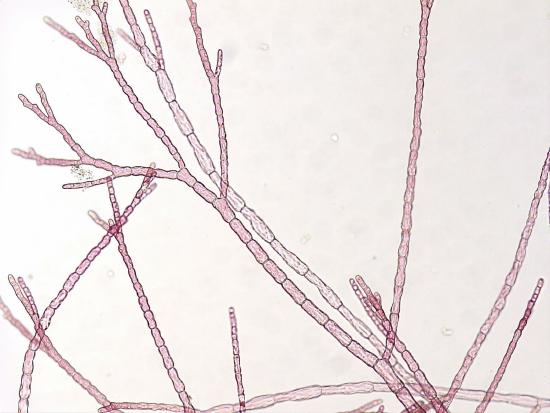 |
 |
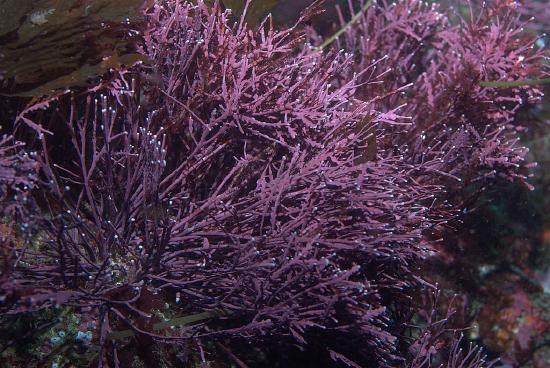 |
Figure \(\PageIndex{7}\): These images show multicellular red algae, which can range from filamentous (first image) to "leafy" (second image, left) to sheet-like (second image, right). The red color is due to an abundance of the red pigment phycoerythrin, which gives this group reddish chloroplasts. First image by Melissa Ha CC-BY-NC. Second image by Maria Morrow CC-BY-NC. Right image: https://commons.wikimedia.org/wiki/F...ed_algae_3.jpg
Green macroalgae
These algae exhibit great diversity of form and function. Similar to red algae, green algae can be unicellular or multicellular. Many unicellular species form colonies and some green algae exist as large, multinucleate, single cells. Green algae primarily inhabit freshwater and damp soil and are a common component of plankton. They have chloroplasts and the photosynthetic pigments chlorophyll a and b, carotene, and xanthophylls. Examples include Chlamydomonas, Chlorella, Pediastrum, Netrium, Hydrodictyon, Acetabularia, Ulva, and Spirogyra. Lichens are a symbiotic combination of fungi and green algae.
The nature of the evolutionary relationships between green algae is still debatable. As of 2019, genetic data supports splitting the green algae into two major lineages: chlorophytes and streptophytes. The green algae exhibit similar features to the land plants, particularly in chloroplast structure. They have chlorophyll a and b, have lost phycobilins but gained carotenoids, and store carbohydrates as starch inside plastids. Green algae are an important source of food for many aquatic animals. Two types of green macroalgae are shown in Figure \(\PageIndex{8}\).
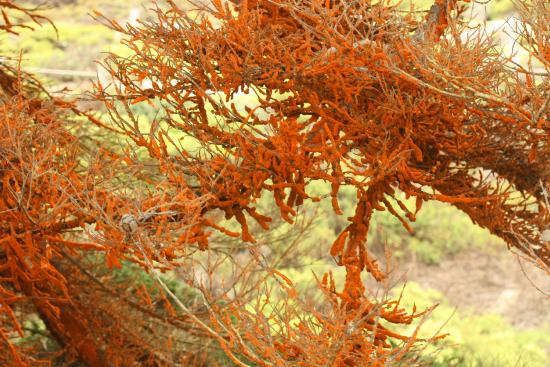 |
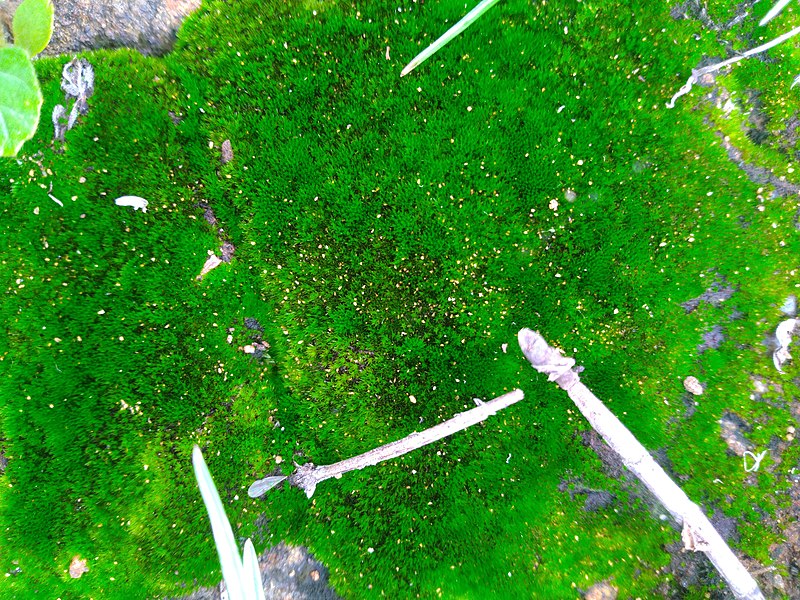 |
Figure \(\PageIndex{8}\):Two types of green macroalgae
left: Figure 5.3.3.125.3.3.12: Trentepohlia is a genus of green algae found in terrestrial environments. It forms fluffy orange colonies on trees and is a photobiont in many lichens. One might not know they were looking at a green algae, due to the orange pigmentation. However, green algae have carotenoids. These terrestrial green algae produce an abundance of carotenoids, perhaps for protection from sun damage. Photo by Scott Loarie, CC0.
Right: fresh water green algae. https://upload.wikimedia.org/wikiped...reen_Algae.jpg
Green macroalgal blooms (called green tides) can also occur (just as blooms from the microalgae cyanobacteria). Green tides in the Yellow Sea (between China and Korea) are the largest known. A particularly large one is shown in Figure \(\PageIndex{9}\):
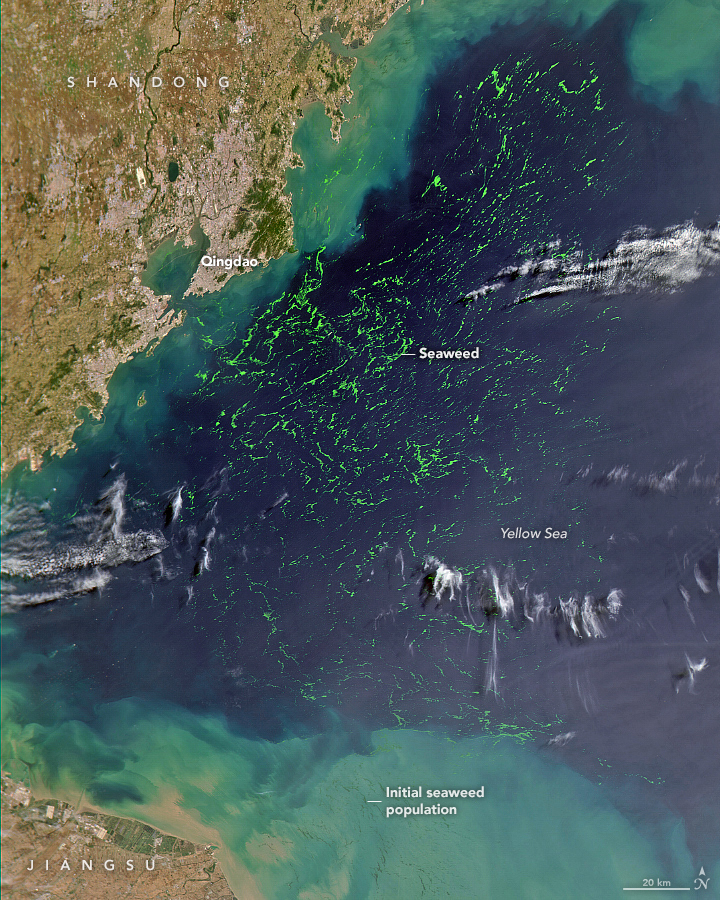
Figure \(\PageIndex{9}\): Green Seaweed in the Yellow Sea , June 2021. https://earthobservatory.nasa.gov/im...the-yellow-sea
This particular green time was from nontoxic green macroalgae, Ulva prolifera. It is often called sea lettuce as it is edible. Blooms can affect the local ecosystem and lead to hypoxic zones as they decay.
Brown macroalgae (also known as Kelp)
(some material below for brown macroalgae from https://bio.libretexts.org/Bookshelv...3A_Brown_Algae)
Macroscopic brown algae arose when a heterotrophic eukaryote merged with a unicellular photosynthetic eukaryotic red algae chloroplasts. The red alga degenerated into a chloroplast, this time with four membranes -- the engulfing membrane from the oomycete, the red alga's plasma membrane, and the two membranes of the original chloroplast within the red alga. The chloroplast has lost one of these membranes in many groups derived from secondary endosymbiosis. Figure \(\PageIndex{10}\) shows this secondary endosymbiosis event.
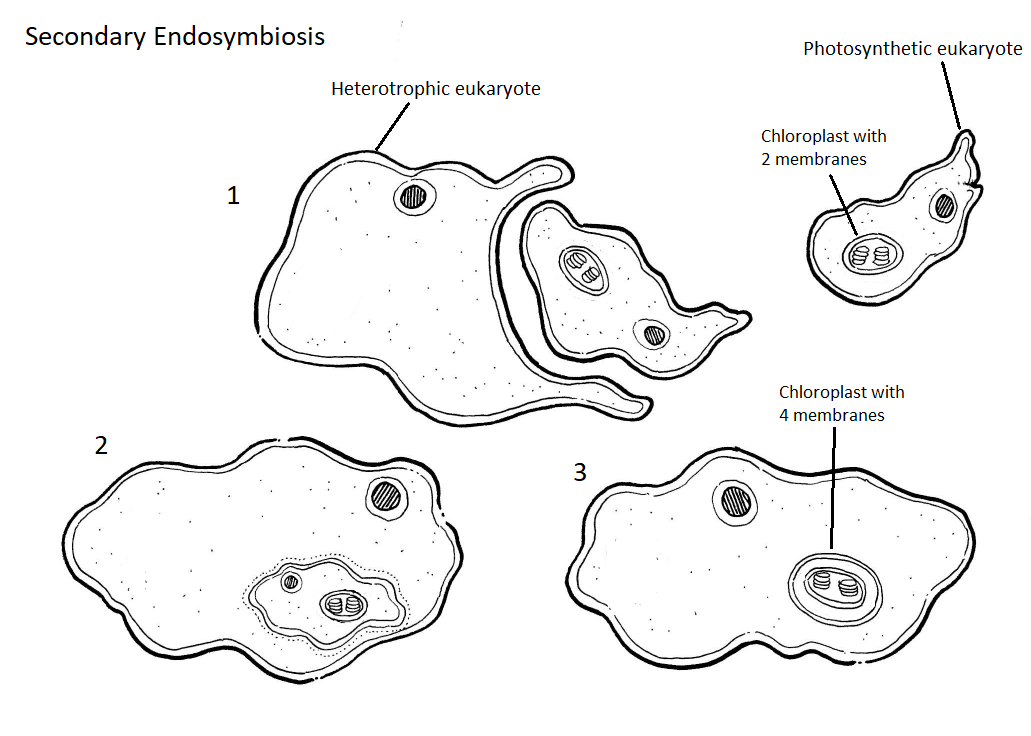
Figure \(\PageIndex{10}\): In the diagram above, we see a unicellular photosynthetic eukaryote with a 2-membrane chloroplast. In step one, this organism is engulfed by a heterotrophic eukaryote. In step two, we see the photosynthetic organism inside the heterotrophic organism. In step three, the original photosynthetic organism has been reduced to a chloroplast with four membranes. Artwork by Nikki Harris CC-BY-NC with added labels by Maria Morrow.
Brown algae are brown due to the large amounts of carotenoids they produce, primarily one called fucoxanthin. These organisms are exclusively multicellular and can get so large that they require special conductive cells to transport photosynthates from their blades down to the rest of their tissues. These conductive cells are called trumpet hyphae and have sieve plates and resemble sieve tubes found in flowering plants.
Much like Saprolegnia, the body of an alga is called a thallus because it is not differentiated into specialized tissues. The general morphology of a brown alga includes a holdfast, stipe, gas bladder(s), and blade(s). Figure \(\PageIndex{111}\) shows a diagram of kelp structure.
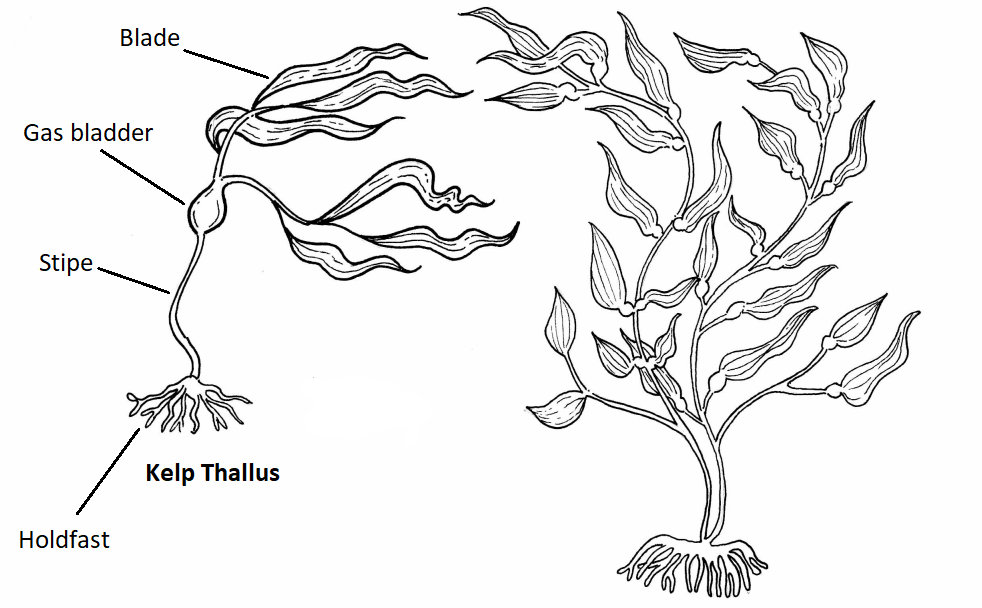
Figure \(\PageIndex{11}\): A diagram of kelp structure. In the diagram above, there are two kelp thalli. The one on the left side is labeled. At the bottom of the thallus is a network of root-like projections that make up the holdfast. The stem-like structure that travels up from the holdfast is the stipe, which terminates in an inflated gas bladder. There are several leaf-like structures attached to the gas bladder. These are blades. The thallus on the right has all these components, but in a slightly different arrangement. Can you find them? Artwork by Nikki Harris CC-BY-NC with added labels by Maria Morrow.
Figure \(\PageIndex{12}\) shows a beautiful image of a kelp forest.
.jpg?revision=1)
Figure \(\PageIndex{12}\): Kelp forest. https://commons.wikimedia.org/wiki/F...1115735%29.jpg
Figure \(\PageIndex{13}\) shows another type of a brown macroalgae.
.jpg?revision=1&size=bestfit&width=349&height=262)
Figure \(\PageIndex{12}\): Underwater "roses" of a brown algae Padina pavonica, commonly known as the peacock's tail (Israel). https://commons.wikimedia.org/wiki/F...l_(Israel).jpg
Now we are in a position to discuss algae as a source of biofuels and nutritive foods in the next chapter section.
- Algae are a diverse group of aquatic organisms that range from simple, single-celled organisms to complex, multicellular forms.
- Algae are photosynthetic organisms and they play a critical role in the Earth's carbon cycle by converting carbon dioxide into oxygen.
- Algae are found in a wide variety of environments, including freshwater, marine, and terrestrial ecosystems.
- Algae have been used for a long time as a source of food, medicine and as a fertilizer.
- Algae are also of great interest as a source of biofuel due to their high growth rates, ability to grow in non-arable land and their ability to produce large amounts of lipids (oils) that can be converted into biofuels.
- Algae are a valuable resource for the production of biofuels, as they are able to produce large amounts of lipids and carbohydrates that can be converted into biofuels.
- Algae-based biofuels have the potential to be more sustainable than biofuels produced from terrestrial crops, as they can be grown in non-arable land and do not compete with food crops for resources.
- Algae can be grown in different systems, including open ponds, closed photobioreactors, and hybrid systems.
- Algae can be grown using a variety of inputs, such as sunlight, CO2, and nutrients, and can produce a wide range of biofuels, including bioethanol, biodiesel, and biomethane.
- Algae-based biofuels are still in the early stages of development, and research is ongoing to improve the efficiency and cost-effectiveness of algae cultivation and biofuel production.
- Algae also have other potential uses, such as for the production of food and feed, as well as for bioremediation and carbon sequestration.


